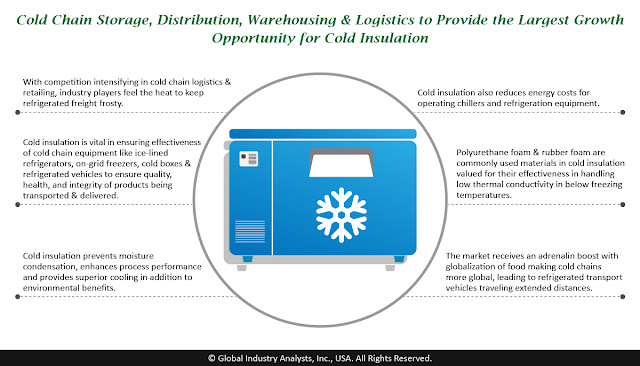The global market for Cold Insulation is projected to reach US$6.9 billion by 2025, driven by the ubiquity and ever-present importance of Industrial refrigeration in food processing, chemical, pharmaceutical manufacturing, refrigerated transport, and liquefied natural gas (LNG), among others. Few of the benefits of cold insulation include lower energy consumption/costs; prevents moisture condensation; enhances industrial process performance; enhances performance of refrigeration equipment; reduces emissions of pollutants; reduces noise; optimum maintenance of process temperatures and improved quality of product manufactured; ensures operating safety and protection of personnel; and prevents mold and mildew growth. Cold insulation also retards condensation by keeping surface temperatures above dew point and as a result restricts corrosion. This is an important advantage for cold pipeline insulation. Environment friendliness is also major economic and financial benefit for companies relying on process refrigeration. Lower energy consumption leads to parallel reduction in VOCs, CEs, NOX, SOX, carbon monoxide and mercury emissions. And in the current era of carbon taxes where companies are made to pay for pollution by punitive regulations, this is an important advantage. Few of the popular materials used in cold insulation include polyurethane foam, rubber foam, and foam glass. While polyurethane foam possesses characteristics such as low smoke emission and low water vapor permeability, rubber foam features high resistance to moisture vapor. Phenolic foams are also widely used. Phenolic foams have a fine cellular structure and a closed cell content of more than 95%. They are lightweight and easy to handle, transport, and install. In addition, they can be manufactured with varying densities, ranging between 35 kg/m3 and 200 kg/m3. High density variants, such as phenolic insulation boards offer superior stability and strength that make them ideal for floor insulation. Moreover, phenolic foams are mold, fungus, and vermin resistant and offer the capability of withstanding temperatures of up to 120oC. Read More…
The global market for Cold Insulation is projected to reach US$6.9 billion by 2025, driven by the ubiquity and ever-present importance of Industrial refrigeration in food processing, chemical, pharmaceutical manufacturing, refrigerated transport, and liquefied natural gas (LNG), among others. Few of the benefits of cold insulation include lower energy consumption/costs; prevents moisture condensation; enhances industrial process performance; enhances performance of refrigeration equipment; reduces emissions of pollutants; reduces noise; optimum maintenance of process temperatures and improved quality of product manufactured; ensures operating safety and protection of personnel; and prevents mold and mildew growth. Cold insulation also retards condensation by keeping surface temperatures above dew point and as a result restricts corrosion. This is an important advantage for cold pipeline insulation. Environment friendliness is also major economic and financial benefit for companies relying on process refrigeration. Lower energy consumption leads to parallel reduction in VOCs, CEs, NOX, SOX, carbon monoxide and mercury emissions. And in the current era of carbon taxes where companies are made to pay for pollution by punitive regulations, this is an important advantage. Few of the popular materials used in cold insulation include polyurethane foam, rubber foam, and foam glass. While polyurethane foam possesses characteristics such as low smoke emission and low water vapor permeability, rubber foam features high resistance to moisture vapor. Phenolic foams are also widely used. Phenolic foams have a fine cellular structure and a closed cell content of more than 95%. They are lightweight and easy to handle, transport, and install. In addition, they can be manufactured with varying densities, ranging between 35 kg/m3 and 200 kg/m3. High density variants, such as phenolic insulation boards offer superior stability and strength that make them ideal for floor insulation. Moreover, phenolic foams are mold, fungus, and vermin resistant and offer the capability of withstanding temperatures of up to 120oC. Read More…


I was more than happy to seek out this net-site.I wished to thanks for your time for this glorious learn!! I undoubtedly having fun with every little bit of it and I've you bookmarked to check out new stuff you blog post. JC Economics online
ReplyDelete